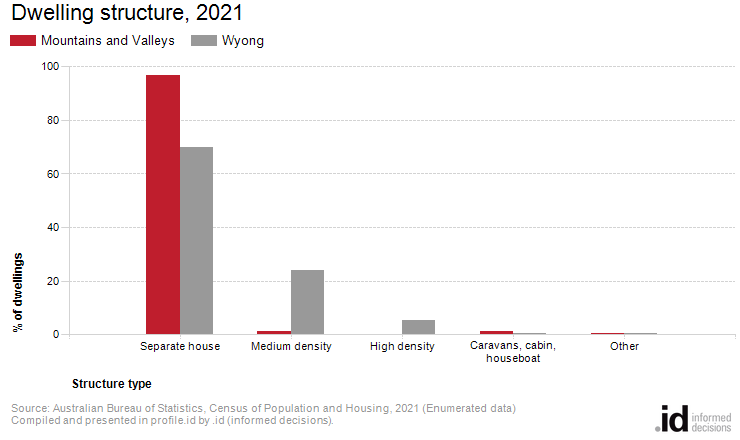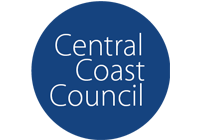Mountains and Valleys
Dwelling type
In Mountains and Valleys, 1.2% of the dwellings were medium or high density, compared to 29% in Wyong.
Dwelling Type is an important determinant of Mountains and Valleys's residential role and function. A greater concentration of higher density dwellings is likely to attract more young adults and smaller households, often renting. Larger, detached or separate dwellings are more likely to attract families and prospective families. The residential built form often reflects market opportunities or planning policy, such as building denser forms of housing around public transport nodes or employment centres.
Dwelling Type statistics should be viewed in conjunction with Household Size, Household Types, Housing Tenure and Age Structure for a more complete picture of the housing market in Mountains and Valleys.
If you're looking at this data to prepare a housing strategy, learn more here.
Derived from the Census:
'Dwelling Structure is derived from the ABS address register supplemented with information from Census Field Officers.'
Dwellings
Source: Australian Bureau of Statistics, Census of Population and Housing (opens a new window) 2016 and 2021. Compiled and presented by .id (opens a new window)(informed decisions).
(Enumerated data)
| Dwelling type | ||||||||
|---|---|---|---|---|---|---|---|---|
| Mountains and Valleys | 2021 | 2016 | Change | |||||
| Dwelling type | Number | % | Wyong % | Number | % | Wyong % | 2016 to 2021 | |
| Occupied private dwellings | 2,894 | 85.2 | 93.7 | 2,896 | 84.9 | 92.1 | -2 | 27500 |
| Unoccupied private dwellings | 493 | 14.5 | 6.2 | 504 | 14.8 | 7.5 | -11 | 27501 |
| Non private dwellings | 10 | 0.3 | 0.1 | 13 | 0.4 | 0.5 | -3 | 27502 |
| Total dwellings | 3,397 | 100.0 | 100.0 | 3,413 | 100.0 | 100.0 | -16 | |
Source: Australian Bureau of Statistics, Census of Population and Housing (opens a new window) 2016 and 2021. Compiled and presented by .id (opens a new window)(informed decisions).
(Enumerated data)

Compiled and presented in profile.id by .id (informed decisions).

Compiled and presented in profile.id by .id (informed decisions).
Dominant groups
In 2021, there were 3,279 separate houses in the area, 39 medium density dwellings, and no high density dwellings. In addition, there were 36 caravans/cabins/houseboats in the area.
Analysis of the types of dwellings in Mountains and Valleys in 2021 shows that 96.9% of all dwellings were separate houses; 1.2% were medium density dwellings, and 0% were in high density dwellings, compared with 69.8%, 24.1%, and 5.2% in the Wyong respectively.
In 2021, a total of 85.2% of the dwellings in Mountains and Valleys were occupied on Census night, compared to 93.7% in Wyong. The proportion of unoccupied dwellings was 14.5%, which is larger compared to that found in Wyong (6.2%).
Emerging groups
The total number of dwellings in Mountains and Valleys decreased by 16 between 2016 and 2021.
The largest change in the type of dwellings found in Mountains and Valleys between 2016 and 2021 was:
- Separate house (+59 dwellings)
